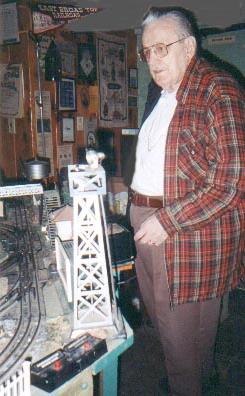|
THREE
hospitalizations and two major surgeries in 1987, and the subsequent
publication of an illustrated article featuring the NORMANED RR in a national model railroad
magazine, had seemingly resulted in my abandonment of model railroading in
favor of an avid diversion of my attention to the [somewhat related] hobby
of topical railway philately. A considerable number of new items purchased
for the model railroad at a National O-Scale convention in June of 1987, and
at a dozen elaborate world-class hobby shops during a 1988 visit with
friends in Southern California, have never made it to the layout . . .
Although I continued to work at gainful employment for six more years
before my retirement in mid-1993, various difficult responsibilities placed
upon me at my workplace resulted in an emotional atmosphere and personal
workload which had stretched my available physical and mental strength to
its limit. There was no room left in my being for “workin' on the railroad.”
|
|
I believe the achievement of national recognition of the layout, added
to this decrease in ambition, energy, physical strength and general and
mental health following two life-threatening illnesses, along with the new
stresses at work, all combined to create (at least subliminally) the cause
of this loss of desire to continue the vigorous active practice of
ferroequinology. It's also a factor that, realistically, the railroad
layouts had grown too large for one individual to maintain properly, so I
redirected my interest entirely to the new pursuit of railways on stamps.
Early in October 2000, a friend and neighbor approached me to “look
over” a “pre-World War II train set” which had been owned by his late
father-in-law. He was interested to know if I could provide him with an
estimate of its worth, and/or determine if the train was in working
condition. He brought the equipment to me in a large box and I promised to
see what I could do within a few days.
The locomotive (a desirable Lionel® No. 1688E) and cars [built
c.1936-'46] appeared to be in excellent condition. However, when I took it
to the basement to test it on my layout, I could not find a single place on
the NORMANED
RR where there was sufficient track
which was not either badly rusted, or electrically “dead,” or both.
 |
|
Grandpa prepares to start up the first train to operate over a
restored portion of Normaned trackage, on Christmas Eve, 2000. |
|
[Later, I was able to place a probable value on my friend's trains, and
one day in the ensuing November, I accompanied him to a Lionel® hobby repair
shop, where he left the locomotive and tender for cleaning, lubrication and
minor repairs. On New Year's Day 2001, my friend told me that the “heirloom
train” had been put in good running order at very reasonable expense].
However, the trauma of this discovery - “close-up and personal” - of
the vast degree of debilitation, destruction and decay which my once
“sparkling” pride and joy had reached, left me discouraged and depressed
about the future of the once lively and exciting model railroad hobby. For a
couple of years, I had been indicating to my son that all or any parts of
the NORMANED
were his for the taking, but there had
been no immediate forthcoming action nor any indication of particular
interest beyond the mention that he and his two sons would “think about it”.
I now felt it was time to either sell the whole works or find a charitable
museum or other railway-related society which would accept it as a gift in
return for removing everything from the premises. But I felt I needed to
give my family one more chance to speak up.
I talked to my son by 'phone that weekend,
and he opined that before the layout was broken up and disposed of, he would
like to see it visually “documented” - perhaps on video tape or some other
medium - and indicated that his sons might be interested in helping with
such a project. As we continued to discuss this during the next couple of
weeks, enthusiasm grew and the resurrection began . . . . |